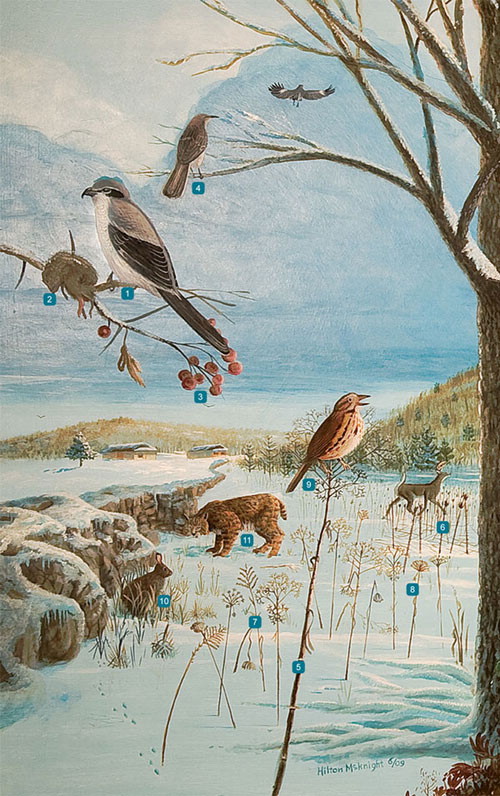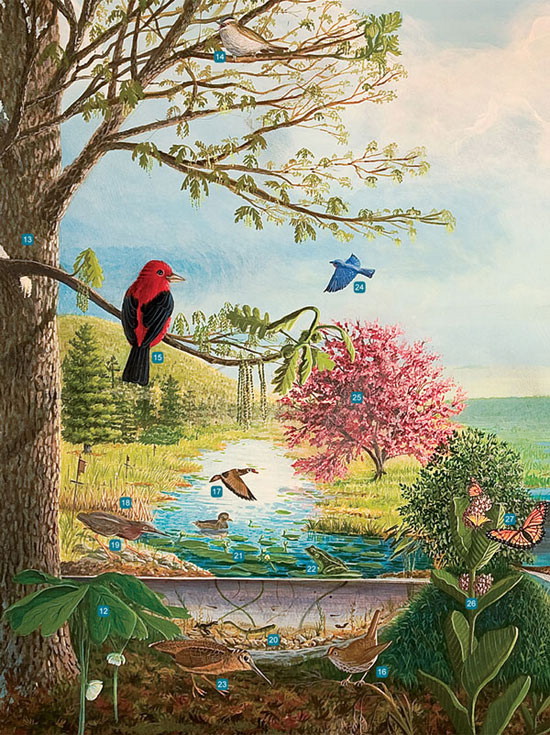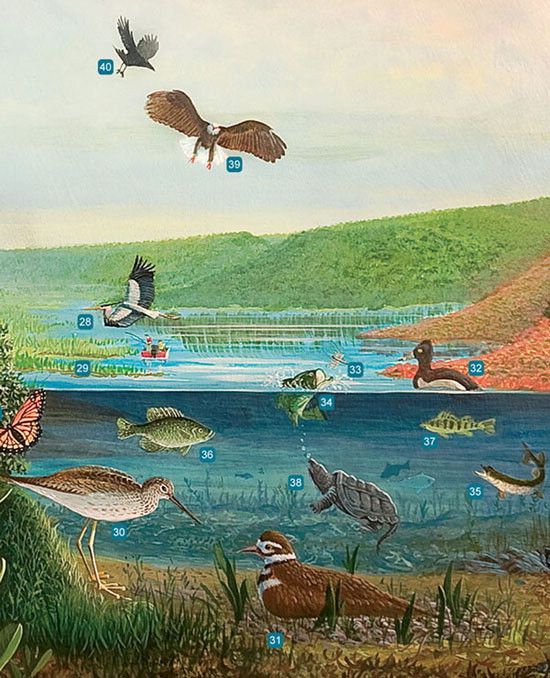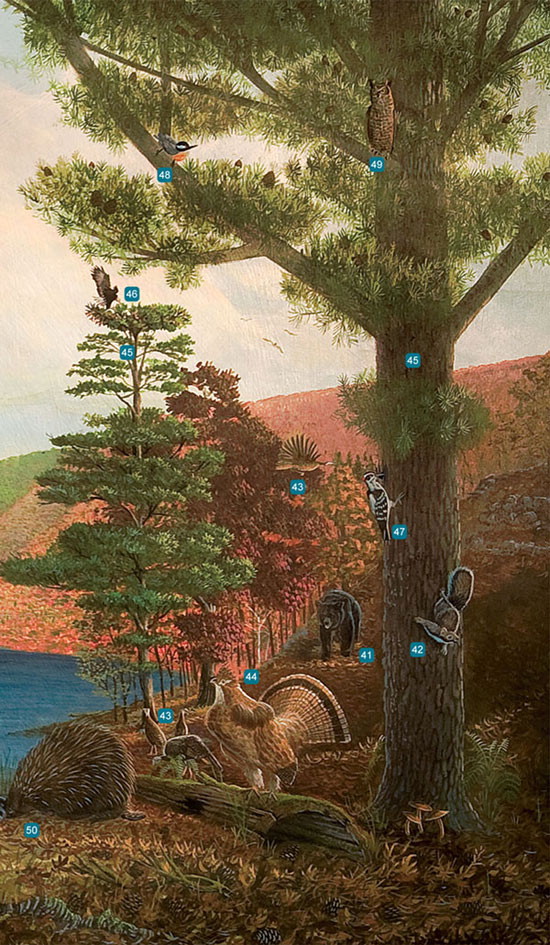Wildlife Watching at Bald Eagle State Park
The diverse geology in the park provides the backdrop for the lake, forests, fields, wetlands, and streams.
Old field habitat throughout the park is undergoing natural succession. Grasses are giving way to goldenrod and asters, and gray dogwood and sumacs are being pushed out by pines and maples.
These fields provide homes for bluebird, monarch butterfly, woodchuck, and cottontail rabbit, while squirrel and downy woodpecker inhabit the woodlots.
A mature oak and hickory forest covers the Bald Eagle Mountain and provides homes for porcupine and turkey.
The edge habitat created when old fields meet woods and wetlands, allows white-tailed deer, woodcock, and red-winged blackbird to thrive.
The lake, created by the Foster Joseph Sayers Reservoir, holds black crappie, largemouth and smallmouth bass, yellow perch, and other warmwater species. The lake also attracts snapping turtles, osprey, great blue heron, and the occasional bald eagle.
Several intermittent streams flow into the lake providing habitat for aquatic insects, crayfish, and minnows.
Foster Joseph Sayers Reservoir draws most of its water from Bald Eagle Creek. The creek flows through limestone making itself and the lake alkaline. These conditions create a good warm-water fishery.
Birding
Bald Eagle State Park contains diverse habitat that attracts many bird species. Beginner and life-long birders find exploring the park with a pair of binoculars a treat no matter what the season.
The mountain ridges create excellent flyways for migrating birds. Some birds stop at the park to rest and feed during their migration. Beginner and life-long birders find exploring the park with a pair of binoculars a treat no matter what the season.
Every spring songbirds like warblers, flycatchers, and swallows display courtship rituals and sing enchanting melodies while searching for nesting spots in the park.
Boaters and beach goers commonly see herons, gulls, geese, and osprey around the lake.
In the fall, you can find migrating mergansers, cormorants, and buffleheads on the lake.
Year-round residents like sparrows, finches, and cardinals can often be seen during the winter in shrubby areas.
Federal, state, and volunteer organizations actively manage the resources of the park to provide a variety of habitats for all wildlife. Dedicated volunteers have established a bluebird trail. About 100 bluebirds fledge annually from the nesting boxes built and maintained by volunteers.
The Common Birds of Bald Eagle State Park (PDF) brochure lists the birds most likely to be seen in the park and in which habitat.
The Habitats of Bald Eagle State Park
Bald Eagle State Park’s geographic location and diversity of habitats attract a large variety of birds. The Allegheny Front to the west of the park is a major flyway for migrating birds (along with butterflies and dragonflies). Birds using the flyway stop at Bald Eagle to rest and feed before continuing their migration.
The park is in the Ridge and Valley Physiographic Province of Pennsylvania, which is characterized by wide valleys surrounded by mountains. This feature is mirrored at the park which slopes from Bald Eagle Mountain down to the valley bottom.
This varied geology leads to many different habitats in the park (PDF), which creates more places for birds and animals to find homes and places to eat.
Winter near the Park Office
The area by the park office is composed of fields slowly reverting to forest. Unmowed grassy areas slowly bristle with shrubs, becoming great habitat for birds that hide and forage hidden in the thick vegetation. In winter, the northern shrike (1), which breeds in northern Canada, winters in the park because of similar habitat. The grassy fields and shrubby areas are just like home and provide habitat for mice, moles and voles (2) the winter food of the shrike, which sometimes stores spare food on the thorns of the hawthorn trees (3). The northern mockingbird (4) is a gray bird often confused with the shrike. Dead and dried joe pye weed (5), teasel (6), goldenrod (7), and Queen Anne’s lace (8), also called wild carrot, are perching spots and seed repositories for year-round birds like song sparrows (9).
This shrubby area has many tasty plants for cottontail rabbits (10), which use the thick underbrush to hide from bobcats (11).
The trails in this area have a maze-like quality as they pass through tall shrubs and grasses. Walking quietly can create close encounters with birds that think they are hidden, but also can be frustrating because a bird can be heard but not seen.

Spring near the Skyline Drive
An amazing aspect of the Skyline Drive area is that you can park your car, take a few steps and feel like you are in the middle of a forest. Although mayapples (12) bloom in late spring, the small, tree-covered hill has little undergrowth, giving it an open feel. Mature trees, like white oak (13), blanket the hill, making good habitat for resident and migrating warblers.
Walking on the top of the Skyline Drive provides views into the upper layers of trees where these warblers live, making them easier to see than in a flat forest. Skyline Drive is a great place for beginner birders.
The red-eyed vireo (14) prefers the tops of trees where it hunts for insects. The scarlet tanager (15), one of the most vibrant birds in the forest, prefers the middle of the tree. The ovenbird (16) hunts and nests on the ground. It’s teacher, teacher call is common spring through early summer.
Next to Skyline Drive is Frog Pond, a great place to see the beautiful wood duck (17). Cattails (18) line the pond, making hiding places for green herons (19) who lurk in the shallows hunting small aquatic creatures. The aquatic phase of the red-spotted newt (20) is bypassed by the hungry heron because they taste terrible. The lily pad-like leaves of spatterdock (21) line the pool, making hiding and sunning locations for green frogs (22) who make their rubber band twang call in early summer. American woodcock (23) use their long bills to probe the soft soil by the pond for earthworms.
Fields near the pond are home to eastern bluebirds (24), which perch on their houses or on the small redbud tree (25) before flying out and snatching flying insects. Please don’t disturb the bluebird nest boxes.
Milkweed (26), the host plant for monarch butterflies (27), flourishes in the fields.

Summer near the Lake Shoreline
Water attracts wildlife. Foster Joseph Sayers Reservoir and the lands near it abound in animals and plants, many of which live only in riparian zones (near water). Great blue herons (28) wade in the shallows of the lake hunting small fish and crayfish. In among the sedges and rushes (29), greater yellowlegs (30) work the shore and shallowest water looking for any small creatures, sometimes joined by killdeer (31), a small sandpiper. In the open water, ring-necked ducks (32) feed on aquatic plants and insects. During spring and fall migration, flotillas of ducks rest and refuel at the lake. Green darner dragonflies (33) hunt for insects over the lake.
Under the water is a hidden world sometimes glimpsed on the hook of a fishing rod. Largemouth bass (34) engulf anything it can in its huge mouth. Muskellunge (35) patrol the lake hunting small fish. Black crappie (36) and yellow perch (37) hunt aquatic insects while hiding from the bigger fish. Snapping turtles (38) lurk on the lake bottom eating whatever wanders too close.
Above the lake, ring-billed gulls, terns and double-crested cormorants flap the length of the reservoir. Feathered mostly in brown, immature bald eagles (39) dive for small fish. Fish crows (40) eat anything they can, stealing food when possible.

Autumn along Bald Eagle Mountain
On Bald Eagle Mountain, the tall trees looming high overhead in this rocky, remote forest can make visitors feel short and maybe insignificant. In the fall, the tree leaves blaze in yellows, oranges, reds and browns. The nuts of the oaks and hickories provide food for many animals, including black bear (41), gray squirrel (42), wild turkey (43), and ruffed grouse (44). The evergreens, like white pine (45), add green color year-round and are a favored nesting place for bald eagles (46). Hairy woodpeckers (47) and red-breasted nuthatches (48) feast on insects in or under the bark of the trees. At night, great horned owls (49) patrol the forest for small prey animals, while porcupines (50) climb to eat the inner bark of trees.